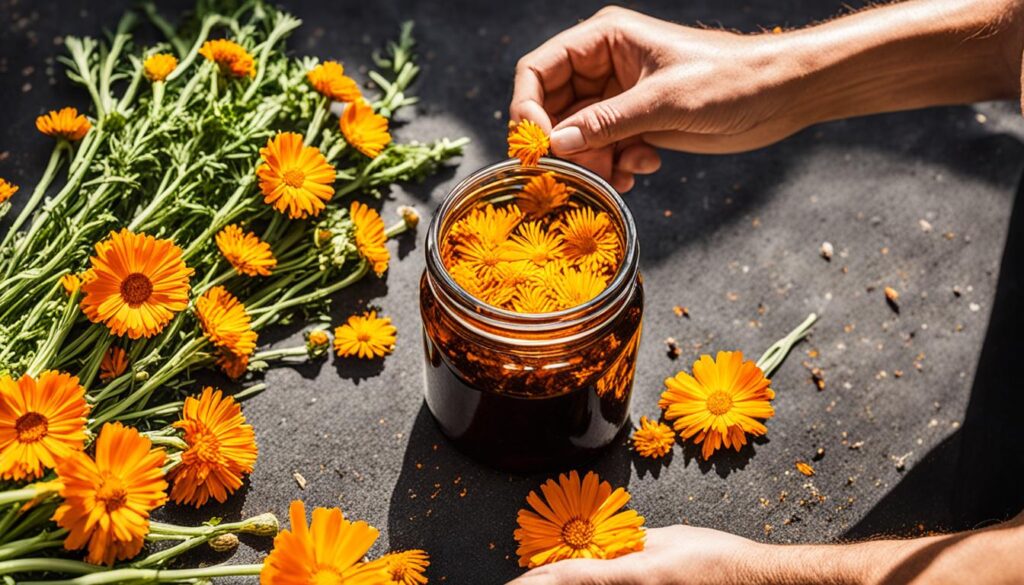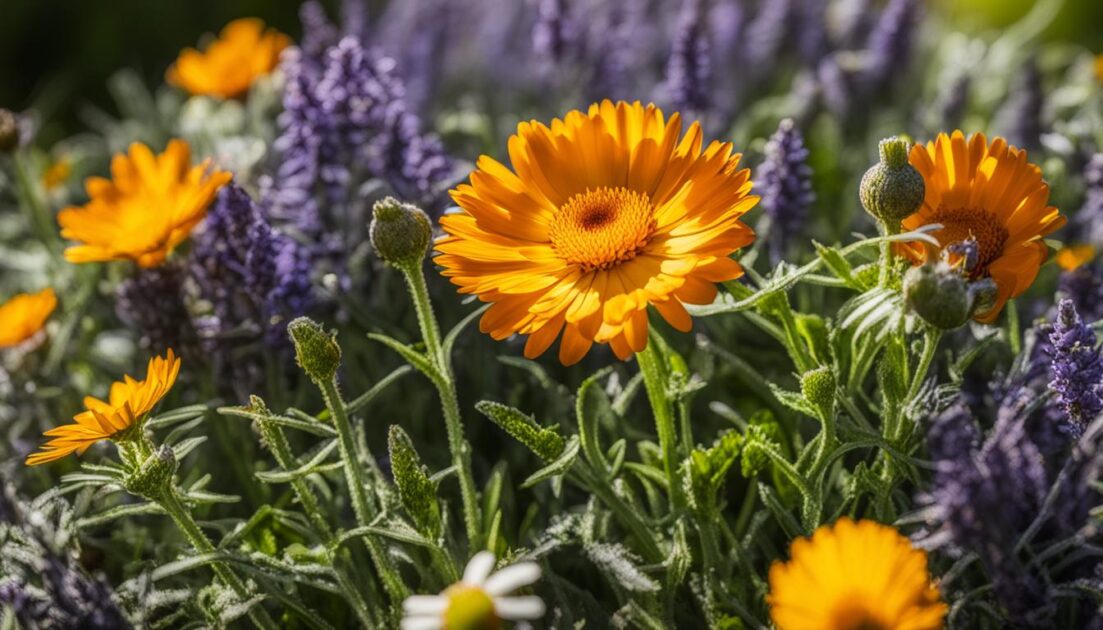Calendula, also known as pot marigold or garden marigold, has long been revered for its medicinal properties. Rich in flavonoids, powerful plant-based antioxidants, calendula offers numerous benefits for health and skincare. From wound healing to anti-aging, this vibrant orange-yellow flower has been utilized for centuries for its therapeutic properties.
Key Takeaways:
- Calendula, or pot marigold, has a rich history of traditional use in treating various ailments.
- Scientific research supports calendula’s effectiveness in wound healing, skincare, and scarring reduction.
- Topical application of calendula in the form of creams, oils, and extracts is common for its therapeutic benefits.
- Caution should be exercised for individuals with plant allergies, pregnant or breastfeeding women, and those on certain medications.
- Choosing high-quality calendula products and growing calendula at home can ensure efficacy and purity.
Calendula for Wound Healing
Calendula, with its remarkable healing properties, has been scientifically proven to accelerate the wound healing process. This beautiful flower increases blood flow and oxygen supply to the affected area, promoting the growth of new tissue and enhancing skin hydration and firmness.
Calendula creams, ointments, and tinctures are widely used to treat various wounds, burns, bruises, and cuts. The soothing properties of calendula help alleviate discomfort and inflammation, while its antimicrobial effects aid in preventing infections.
Studies have also shown the efficacy of calendula in treating hemorrhoids. Regular application of calendula cream or ointment can provide relief from pain, itching, and swelling associated with hemorrhoids.
Although there is limited scientific research specifically on calendula’s wound healing properties in humans, it is generally considered safe for topical application. Its gentle nature makes it suitable for both adults and children.
“Calendula’s healing properties make it an excellent natural remedy for a wide range of wounds and skin conditions.”
Whether it’s a minor cut, a burn, or a stubborn bruise, calendula can provide the healing and soothing touch you need. Incorporating calendula creams, ointments, or tinctures into your wound care routine can significantly expedite the healing process and enhance overall skin health.
Calendula for Skin Conditions
Calendula is a versatile herb known for its soothing and anti-inflammatory properties, making it an effective natural remedy for various skin conditions. Whether you’re dealing with eczema, dermatitis, or dandruff, calendula can provide relief and promote healthier skin.
When it comes to skincare, calendula works by promoting collagen production, which helps maintain hydrated and nourished skin. Its gentle nature makes it suitable for sensitive skin, and it is even commonly used in baby care products to treat conditions like diaper rash and cradle cap.
You can incorporate calendula into your skincare routine by using topical products such as creams, lotions, and balms. These formulations are specifically designed to reduce inflammation and provide relief to affected areas. Calendula lotions and balms are particularly effective for soothing and hydrating dry, irritated skin.
By choosing calendula products for your skincare needs, you can harness the power of this natural herb to alleviate the discomfort caused by various skin conditions, leaving your skin feeling calm, nourished, and healthy.
Benefits of Calendula for Skin Conditions:
1. Soothes and calms irritated skin
2. Reduces inflammation
3. Promotes collagen production
4. Maintains skin hydration
5. Gentle and suitable for sensitive skin
6. Provides relief for eczema, dermatitis, and dandruff
7. Effective in treating baby skin conditions like diaper rash and cradle cap
Whether you’re dealing with a minor rash or a chronic skin condition, calendula can offer a natural and gentle solution. Its soothing properties work to reduce inflammation and nourish the skin, providing much-needed relief.
How to Use Calendula for Skin Conditions:
Applying calendula creams, lotions, or balms directly to the affected areas is the most common method of using calendula for skin conditions. Massage the product into the skin gently until fully absorbed. For optimal results, follow the product’s instructions and use it as frequently as recommended.
In addition to topical application, you can also brew calendula tea and use it as a gentle rinse for irritated scalp or as a soothing compress for skin conditions like eczema and dermatitis.
Remember to perform a patch test before using any new skincare product, including those containing calendula. If you experience any adverse reactions or worsened symptoms, discontinue use and consult a healthcare professional.
Expert Tip:
“For maximum efficacy in treating skin conditions, look for calendula products that are specifically formulated for the targeted concern, such as calendula-infused lotions for eczema or dermatitis.”

Calendula Product Recommendations for Skin Conditions
| Product | Description |
|---|---|
| Calendula Cream | A hydrating and soothing cream infused with calendula extract to reduce inflammation and relieve itching. |
| Calendula Lotion | A lightweight lotion enriched with calendula oil to moisturize and calm irritated skin. |
| Calendula Balm | A concentrated balm with calendula extract to provide intense hydration and targeted relief for dry, irritated areas. |
Calendula for Anti-Aging
Calendula, with its powerful antioxidants and anti-inflammatory compounds, has gained significant attention for its potential anti-aging effects. The natural properties of calendula play a crucial role in protecting the skin against oxidative stress, a major contributor to aging and various illnesses.
By reducing oxidative stress, calendula helps slow down the development of wrinkles and fine lines, keeping the skin youthful, hydrated, and healthy. Its nourishing properties make it an ideal ingredient in skincare products, particularly daily lotions and lip balms, that aim to promote a glowing complexion.
While research specifically on calendula’s anti-aging effects is still limited, its antioxidant properties are well-established. These antioxidants help neutralize free radicals and minimize the damage they cause to the skin cells, resulting in a more youthful appearance and enhanced overall skin health.
Enhancing Skin Health with Calendula’s Antioxidants
Calendula’s potent antioxidants work to combat the signs of aging by protecting the skin from environmental stressors and potential DNA damage. These antioxidants prevent collagen breakdown, which is crucial for maintaining skin elasticity and firmness. By promoting collagen production, calendula helps to improve the skin’s texture and reduce the appearance of fine lines and wrinkles.
“Calendula’s antioxidant properties help protect the skin from aging by reducing the impact of free radicals and promoting collagen production.”
Keeping the Skin Hydrated and Healthy
Calendula’s moisturizing properties contribute to its anti-aging benefits. Hydrated skin appears plumper and smoother, reducing the appearance of wrinkles and fine lines. Calendula-infused skincare products help lock in moisture, keeping the skin supple, soft, and youthful. Regular use of calendula-based products can contribute to long-term skin health.
Evidence-based Approach to Calendula for Anti-Aging
While research on calendula’s anti-aging effects is ongoing, numerous anecdotal reports and traditional uses support its potential. However, it is essential to approach calendula as a complementary addition to a well-rounded skincare routine rather than a standalone solution.
Key Takeaways:
- Calendula’s antioxidants protect against oxidative stress, a major contributor to aging.
- Reduced oxidative stress helps slow down the development of wrinkles and fine lines.
- Calendula-infused skincare products promote youthful, hydrated, and healthy skin.
- Moisturizing properties of calendula contribute to improved skin texture and reduced signs of aging.
- Calendula can be used as a complementary addition to a well-rounded skincare routine.
| Calendula for Anti-Aging | |
|---|---|
| Benefits | How it Works |
| Nourishes the skin and promotes a youthful complexion | By reducing oxidative stress and collagen breakdown |
| Improves skin texture, reducing the appearance of wrinkles and fine lines | By promoting collagen production and enhancing skin hydration |
| Protects against environmental stressors that accelerate aging | By neutralizing free radicals and preventing DNA damage |
Calendula for Scarring
Calendula’s healing properties extend to reducing scarring. It promotes proper blood flow to the injured area, speeds up the healing process, and encourages the growth of healthy new tissue. Calendula is particularly beneficial in reducing scarring from wounds, chickenpox, and acne. It softens and soothes the skin, prevents inflammation, and boosts the immune response, leading to quick and clean wound healing. Calendula creams, ointments, and oils can be applied directly to scars to aid in their reduction.
| Benefits of Calendula for Scarring | Methods of Application |
|---|---|
| Promotes proper blood flow to the injured area | Calendula creams |
| Speeds up the healing process | Calendula ointments |
| Encourages the growth of healthy new tissue | Calendula oils |
| Softens and soothes the skin | |
| Prevents inflammation | |
| Boosts the immune response |
Calendula’s healing abilities help reduce the appearance of scars from various sources, including wounds, chickenpox, and acne. It works by promoting proper blood flow, accelerating the healing process, and stimulating the growth of healthy new tissue. Additionally, calendula softens and soothes the skin, prevents inflammation, and boosts the immune response, resulting in quick and clean wound healing.
Calendula can be conveniently applied topically using creams, ointments, or oils directly to the affected area. This allows the healing properties of calendula to penetrate the skin and target the scar tissue, helping to reduce its appearance over time.
How to Use Calendula
Calendula, with its versatile properties, can be used in various forms to address different needs. Here are three popular ways to incorporate calendula into your daily routine:
1. Calendula Tea
To make calendula tea, steep dried flowers in boiling water for 10-15 minutes. Strain and enjoy the soothing herbal infusion. Calendula tea can be consumed for its potential health benefits or used as a mouth rinse for sore throats.
2. Calendula Oil
Calendula oil is made by infusing the flowers in carrier oils like olive oil or coconut oil. This oil can be applied topically to moisturize and nourish your skin. It is commonly used as a base for creams, lotions, and balms. Calendula oil is also found in skincare products targeted towards sensitive skin.
3. Calendula Extract
Calendula extract is a concentrated form of the plant’s active compounds. It can be incorporated into various beauty and personal care products like deodorants, body lotions, and facial serums. Calendula extract enhances these products with its soothing and rejuvenating properties.
Remember to store your calendula products in a dry, dark place to maintain their efficacy. Incorporating calendula into your routine can help harness its potential benefits and promote overall well-being.

Precautions and Side Effects
While calendula is generally safe for topical use, it is important to be aware of certain precautions and potential side effects. Here are some important considerations:
- Allergies: People who have allergies to plants in the daisy or aster family, such as chrysanthemums and ragweed, may also experience allergic reactions to calendula. It is advisable to perform a patch test before using calendula products if you have known allergies.
- Pregnancy and breastfeeding: Pregnant and breastfeeding women should avoid using calendula due to its potential effects on hormone levels and the risk of miscarriage. It is best to consult with a healthcare provider before introducing any new products during these periods.
- Medication interactions: Calendula may interact with certain medications, including those that slow blood clotting or medications used to suppress the immune system. It is important to consult with a healthcare provider before using calendula if you are taking any medications to avoid potential interactions.
- Long-term use: There is limited research available on the long-term use of calendula. It is advisable to use calendula with caution and to discontinue use if any adverse effects occur.
As with any natural product, it is always recommended to consult with a healthcare provider before incorporating calendula into your skincare routine or using it for any therapeutic purposes. They can provide personalized advice and ensure it is safe for your specific circumstances.
Potential Precautions and Side Effects of Calendula
| Precautions and Side Effects | Details |
|---|---|
| Allergies | Individuals with allergies to plants in the daisy or aster family may also have allergic reactions to calendula. |
| Pregnancy and Breastfeeding | Pregnant and breastfeeding women should avoid using calendula due to potential effects on hormone levels and the risk of miscarriage. |
| Medication Interactions | Calendula may interact with certain medications, including those that slow blood clotting or suppress the immune system. |
| Long-Term Use | There is limited research on the long-term use of calendula, so it is advisable to use it with caution and discontinue use if any adverse effects occur. |
Growing and Harvesting Calendula
Calendula is an easy-care plant that can be grown in various environments, either in a garden or in pots. It is tolerant of different soil types and requires limited watering. Calendula plants bloom with vibrant flowers, and harvesting the petals every few days promotes continuous blooming. The dried petals can be used to make teas, oils, and other skincare products. Growing calendula at home allows for the creation of DIY skincare remedies using fresh, organic petals, ensuring the highest quality and efficacy.
Here are some key tips for growing and harvesting calendula:
- Choose a sunny spot: Calendula thrives in full sun, so select a location in your garden or balcony that receives at least six hours of sunlight daily.
- Prepare the soil: Ensure the soil is well-draining and enriched with organic matter. Calendula can tolerate poor soil conditions but performs best in loose, loamy soil.
- Sow the seeds: Calendula seeds can be sown directly into the garden or started indoors and transplanted later. Sow the seeds ¼ inch deep and about 6 inches apart.
- Water adequately: Calendula plants require regular watering, especially during dry spells. Keep the soil moist but avoid overwatering, as excessive moisture can lead to root rot.
- Pinch back the plants: To encourage bushier growth and more flowers, pinch back the growing tips of the calendula plants when they reach a height of 6-8 inches.
- Harvest the petals: Once the calendula flowers have fully bloomed, pluck the petals gently every few days to promote continuous flowering. Remove the petals from the flower heads and spread them out to dry in a well-ventilated area away from direct sunlight.
With your freshly harvested calendula petals, you can make a variety of DIY skincare products:
- Calendula-infused oil: Place dried calendula petals in a clean jar and cover with a carrier oil like olive or coconut oil. Leave the jar in a sunny spot for 2-3 weeks, shaking it occasionally. Strain the oil, and you’ll have a nourishing base for homemade creams, lotions, and balms.
- Calendula tea: Steep dried calendula petals in hot water for 10-15 minutes to create a soothing herbal tea. You can enjoy it as a beverage or use it as a rinse for your hair or as a compress on your skin.
- Calendula salve: Melt beeswax and your calendula-infused oil together, and pour the mixture into small containers to solidify. This salve can be used to moisturize dry skin, soothe minor irritations, and promote healing.
By growing and harvesting calendula, you have the opportunity to create your own natural skincare remedies that are free from additives and chemicals. The vibrant blossoms and beneficial properties of calendula petals make them a valuable ingredient for a healthy and radiant complexion.

Traditional and Modern Uses of Calendula
Calendula, a versatile plant, has a rich history in traditional medicine for various ailments such as stomach upset, ulcers, and menstrual cramps. While scientific evidence for these traditional uses is limited, calendula’s healing and anti-inflammatory properties have made it a popular ingredient in modern skincare and cosmetic products.
Calendula is widely used in lotions, creams, soaps, shampoos, and wound treatments. Its soothing properties help to calm irritated skin, reduce inflammation, and promote healing. When used in skincare products, calendula can improve the overall health and appearance of the skin, providing hydration and a youthful glow.
Moreover, calendula’s vibrant orange-yellow petals are also utilized in culinary preparations to add both flavor and visual appeal. The petals can be used as a spice to infuse dishes with a subtle, floral taste. Calendula petals can be sprinkled over salads, soups, or used to garnish desserts, giving a fresh and vibrant touch to meals.
Overall, the traditional uses of calendula highlight its historic significance as a medicinal herb, while the modern uses demonstrate its versatility in skincare and culinary applications.
Key Points:
- Calendula has a long history in traditional medicine, used for ailments like stomach upset, ulcers, and menstrual cramps.
- Despite limited scientific evidence, calendula’s healing and anti-inflammatory properties make it a popular ingredient in modern skincare and cosmetic products.
- Calendula is commonly used in lotions, creams, soaps, shampoos, and wound treatments for its soothing and healing effects.
- In culinary preparations, calendula petals are used as a spice to add flavor and vibrant color to dishes.
- The versatile nature of calendula makes it a valuable addition to both traditional and modern healing practices.
Choosing High-Quality Calendula Products
When it comes to selecting calendula products, ensuring their quality is crucial for both effectiveness and safety. Opting for high-quality options guarantees that you reap the full benefits of this remarkable plant. Look for products that are made with organic calendula, ensuring that it is grown without the use of harmful substances and chemicals.
Another indicator of quality is third-party certification. These certifications provide assurance of the product’s quality, purity, and adherence to strict standards. Look for reputable certifications on the packaging, such as USDA Organic or Ecocert, which validate the integrity of the product.
If you truly want to ensure the highest quality, consider growing calendula at home and making your own remedies using fresh petals. This allows you to have full control over the cultivation and extraction process, resulting in a truly organic, high-quality product that you can trust. Store your homemade products in dry, dark places to preserve their potency.
It’s important to note that while calendula has numerous benefits, it is not approved by the FDA for specific therapeutic claims. However, by choosing high-quality products from reputable sources and ensuring proper storage, you can still experience the healing properties of calendula, making it a valuable addition to your self-care routine.
FAQ
What are the benefits of calendula?
Calendula has antioxidant properties, promotes wound healing, soothes skin conditions, has anti-aging effects, and reduces scarring.
How can calendula help with wound healing?
Calendula accelerates the healing process, promotes new tissue growth, and improves hydration and firmness of the skin. Calendula creams and ointments can be used to treat wounds, burns, bruises, and cuts.
Can calendula be used for skin conditions?
Yes, calendula has soothing and anti-inflammatory properties that make it useful for treating eczema, dermatitis, and dandruff. Calendula lotions and balms can be applied to affected areas to reduce inflammation.
Does calendula have anti-aging effects?
Calendula’s antioxidant properties help reduce oxidative stress and slow down the development of wrinkles. It also keeps the skin hydrated and healthy, promoting a youthful appearance. Calendula can be found in daily lotions and lip balms.
Can calendula reduce scarring?
Yes, calendula promotes proper blood flow, speeds up the healing process, and encourages the growth of healthy tissue, reducing scarring from wounds, chickenpox, and acne. Calendula creams and oils can be applied directly to scars to aid in their reduction.
How can I use calendula?
Calendula can be used in various forms. It can be steeped in boiling water to make tea or infused in carrier oils like olive oil to create calendula oil. Calendula extract can also be incorporated into skincare products like deodorants and lotions.
Are there any precautions or side effects of using calendula?
People with allergies to plants in the daisy or aster family may have an allergic reaction to calendula. Pregnant and breastfeeding women should avoid using calendula. It may also interact with certain medications. Consult with a healthcare provider before use.
How can I grow and harvest calendula?
Calendula is an easy-care plant that can be grown in gardens or pots. It is tolerant of different soil types and requires limited watering. Harvest the petals every few days to promote continuous blooming, and use the dried petals to make teas and skincare products.
What are the traditional and modern uses of calendula?
Calendula has been traditionally used for stomach upset, ulcers, and menstrual cramps. In modern times, it is used in skincare and cosmetic products such as lotions, creams, soaps, shampoos, and wound treatments. It is also used as a spice in culinary preparations.
How can I choose high-quality calendula products?
Look for organic calendula products that are free from harsh substances and chemicals. Third-party certifications can provide assurance of quality and purity. Growing calendula at home and making DIY remedies using fresh petals ensures the highest quality.






